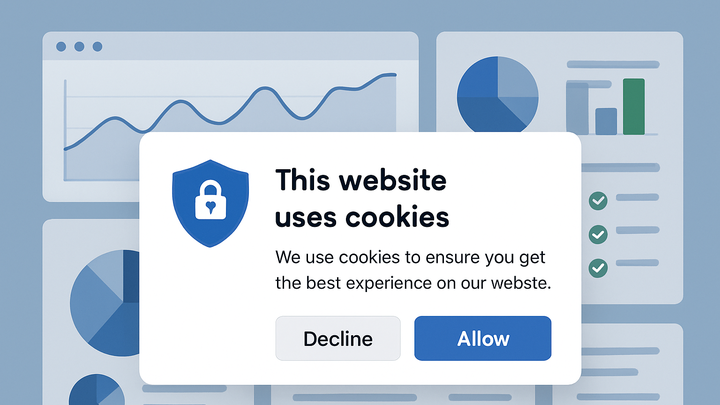Published on 2025-06-27T21:05:00Z
What is Consent Management? Examples with PlainSignal and GA4
Consent management in analytics refers to the systematic process of obtaining, storing, and enforcing user permission before collecting or processing personal data on websites and applications. It ensures that all tracking scripts, cookies, and data collection mechanisms only activate after explicit opt-in from the user, aligning with global privacy laws such as GDPR and CCPA. Without proper consent management, organizations risk non-compliance penalties, loss of user trust, and skewed analytics data due to blocked or delayed scripts. Modern analytics platforms and consent management tools can be integrated to streamline the consent workflow, provide transparency, and maintain an audit trail of user decisions. By implementing robust consent management, businesses can uphold privacy standards while still gaining valuable insights into user behavior.
Consent management
Process for collecting, storing, and enforcing user consent for analytics data in compliance with privacy laws.
Overview of Consent Management
Consent management is the process of soliciting, tracking, and managing user permission for data processing in alignment with privacy regulations. In analytics, it ensures data collection only occurs after explicit opt-in, preserving user trust and legal compliance.
-
Definition
Consent management is the structured process of obtaining and recording user permission before processing personal data, ensuring analytics scripts run only after opt-in.
-
Objectives
Protect user privacy, comply with data protection laws, and maintain data integrity for analytics insights.
-
Regulatory context
Driven by laws like GDPR and CCPA, which require explicit user consent before collecting personal or behavioral data.
Core Components
A robust consent management framework for analytics includes several key building blocks that work together to ensure lawful data processing and user trust.
-
Consent collection
Mechanisms for capturing user permission, typically via banners or preference centers.
-
Cookie banner
A pop-up interface prompting users to accept or reject cookies.
-
Preference center
A dashboard where users can adjust consent settings by category.
-
-
Consent storage
Securely recording consent decisions with metadata like timestamps and versions.
-
Centralized database
Stores consent records in a secure, queryable system.
-
Timestamping
Logs the exact time a user gave or withdrew consent.
-
-
Consent enforcement
Preventing analytics scripts from executing or processing data without proper consent.
-
Script blocking
Delays or disables tags until the user opts in.
-
Consent signals
Integrates with tag managers to pass consent status programmatically.
-
-
Reporting & auditing
Tracking consent records and generating compliance reports for legal audits.
-
Audit logs
Detailed logs of consent changes and user interactions.
-
Compliance reports
Summarized data on consent rates and statuses over time.
-
Implementing Consent Management in Practice
Example integrations with analytics platforms like PlainSignal and Google Analytics 4 demonstrate how to enforce consent before data collection.
-
PlainSignal
A cookieless analytics solution that respects user privacy by design. Integration involves adding a script that only runs after loading the consent manager.
<link rel="preconnect" href="//eu.plainsignal.com/" crossorigin /> <script defer data-do="yourwebsitedomain.com" data-id="0GQV1xmtzQQ" data-api="//eu.plainsignal.com" src="//cdn.plainsignal.com/plainsignal-min.js"></script>-
Cookie-free approach
Collects aggregated metrics without storing cookies or personal data.
-
Simple integration
Minimal script load and no need for cookie banners if set to non-cookie mode.
-
-
Google analytics 4 (GA4)
GA4’s Consent Mode allows analytics tags to adjust behavior based on user consent settings. You can configure default consent or react in real time.
<script async src="https://www.googletagmanager.com/gtag/js?id=GA_MEASUREMENT_ID"></script> <script> window.dataLayer = window.dataLayer || []; function gtag(){dataLayer.push(arguments);} gtag('consent', 'default', { 'analytics_storage': 'denied' }); gtag('js', new Date()); gtag('config', 'GA_MEASUREMENT_ID'); </script>-
Consent mode api
Controls analytics and ad_storage based on permissions.
-
Gtag configuration
Use gtag(‘consent’) calls to set and update consent states dynamically.
-
Best Practices
Applying proven strategies enhances user trust and ensures ongoing compliance in consent management.
-
Transparency & clarity
Explain what data you collect and why, in simple language.
-
Clear wording
Avoid legal jargon; use straightforward descriptions.
-
Visual cues
Use icons or color coding to highlight consent options.
-
-
Granular control
Allow users to opt in or out by specific purposes rather than all-or-nothing.
-
Purpose-based options
Separate choices for analytics, marketing, and preferences.
-
Technical controls
Integrate with tag managers for fine-grained script management.
-
-
Regular reviews
Periodically audit consent flows and update policies to reflect new regulations.
-
Policy updates
Align with changes in GDPR, CCPA, and other laws.
-
User feedback
Gather user input to improve consent UX.
-
-
Minimal data collection
Limit data gathering to what’s strictly necessary for analytics or operations.
-
Data minimization
Only track metrics essential for business insights.
-
Aggregate reporting
Focus on aggregated, anonymized data when possible.
-
Challenges & Considerations
Even with best intentions, implementing consent management can encounter obstacles that must be navigated carefully.
-
Balancing analytics needs vs. privacy
Finding the sweet spot between rich data insights and respecting user privacy.
-
Cross-border data transfers
Regulations may differ by region; transferring data internationally adds complexity.
-
Technical integration complexity
Coordinating multiple scripts, tag managers, and consent platforms requires careful planning.
